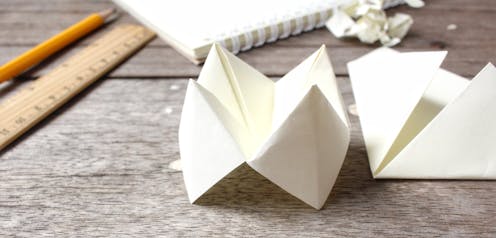What’s in your future? ‘Fortune tellers’ paper game helps children acquire fine motor and language skills

Making “fortune tellers” — a folded paper game children hold on their fingers and thumbs and practice counting and “telling fortunes” with — has been a time-treasured craft and play activity for generations across cultures.
One of the earliest known paper-folding instruction books is Japanese, dated to 1797; German educators also encouraged paper folding in 19th-century kindergarten curricula. In English, “fortune tellers” are sometimes called salt cellars, chatterboxes or cootie catchers; in my own family heritage language, Dutch, they are happertje (meaning “bite”).
This single activity integrates and provides a context for children to acquire and apply key concepts and skills from important domains of early development. These include physical health and well-being, including fine motor manipulative skills; language and cognitive development, which includes word knowledge; and social competence.
The activity promotes connected, accelerated and robust understanding through guided, engaged play.
Experiential learning in a game
It is important to underscore that different domains of children’s early development are interrelated and interdependent.
Orchestrating activities that exploit interaction among the domains supports young children in their quest to unite disparate or discrete “bits and pieces” of concept and skill understanding. In this way children have practice bringing different tasks and embodied knowledge into a coherent conceptual system.
In children, experiential learning that engages neurocircuity connecting the brain and hands and is mediated through adult talk is key to learning language for making meaning in the brain.
The psychologist Jean Piaget describes the early development needs of children as concrete learners, meaning direct contact with objects and materials in real time. The importance of the “more knowledgeable other” and the role of language interactions in supporting ongoing learning was underscored by the psychologist Lev Vygotsky.
Different learning goals
Let’s isolate some important learning goals that a fortune teller task supports.
Fine motor manipulative and fine motor literacy skills are developed through scissor work to cut a square. Working on a good pincer grip through handling crayons and pencils happens when children print messages and numbers.
Folding, creasing, cutting, colouring, drawing and writing/printing supported by adults talking with children helps children learn procedural language and specialized vocabulary connected to numeracy and visual spatial concepts like diagonal, triangle, half.
And concepts of shape are foundational to children’s ability to recognize letters that underpin literacy learning. When children play with their fortune tellers, they practice counting out loud connected to finger movement.
As a birthday greeting
The social and emotional domain can be developed when children write thoughtful wishes for birthdays. Young children can start with drawing balloons, cake and candles to go under the flaps of a birthday greeting fortune teller card. Such activities promote emotional well-being for both recipient and sender.
Read more: Handwritten valentines create a legacy of love and literacy
Children could also write many other messages related to affirmations, random acts of kindness, mindfulness and ideas for behaviour and stress management.
Cognitive development can be nurtured with playful practice of times tables, jokes and riddles that encourage solving a problem, retelling and narrating a sequence of events.
Children reveal important information about their developmental readiness and progress, and their learning needs are visible in completing small projects such as making fortune tellers. A weak pincer grip, for example, might signal the need for more focused finger exercises with clothes pegs, games with chop sticks or pick up sticks.
Making the fortune teller
Making fortune tellers involves about 11 folds — a multi-step task that will involve step-by-step help for young learners.
You could use one of many diagrams available online. Or, on YouTube, a video from “Maflingus” (or Miami Flip, as he introduces himself) on how to make a fortune teller explains the folding technique in straightforward language. I was drawn to give this youngster the opportunity to explain the process as I worked with two children in completing the task. He did not disappoint!
Children benefit from adults offering them input in multiple ways. As an adult leading the task, you can talk and give hands-on support when making the diagonal folds.
Break tasks into manageable chunks or steps. This might involve first creating a model of the final product. Offer specific feedback and encouragement at each step and backing up to review if necessary.
Completing this one-shot project was motivating, fun and purposeful for the children who decided to make this into a birthday wish for their father for later that day.
Not just for little kids
Older students can benefit from using the fortune teller as a study strategy. Under the flaps, students might generate handwritten notes and summaries. Reviewing key concepts and vocabulary or definitions and formulas all promote deep processing and learning.
Handwriting creates embodied cognition and memory in the neurocircuitry that we know works as a key study technique. It produces the added bonus of having a handy, permanent external memory support and storage space that can be revisited for quick review.
All the boxes
Though there are endless free and commercially available resources for making fortune tellers, tailored to different themes including printouts or colouring pages available online. I prefer a heartfelt hand-printed message, joke and a bit of art work, and as this article explains, the many benefits of starting from scratch.
Few learning tasks are able to integrate and target many developmental domains at once … fortune tellers tick all the boxes.
Hetty Roessingh receives funding from SSHRC
